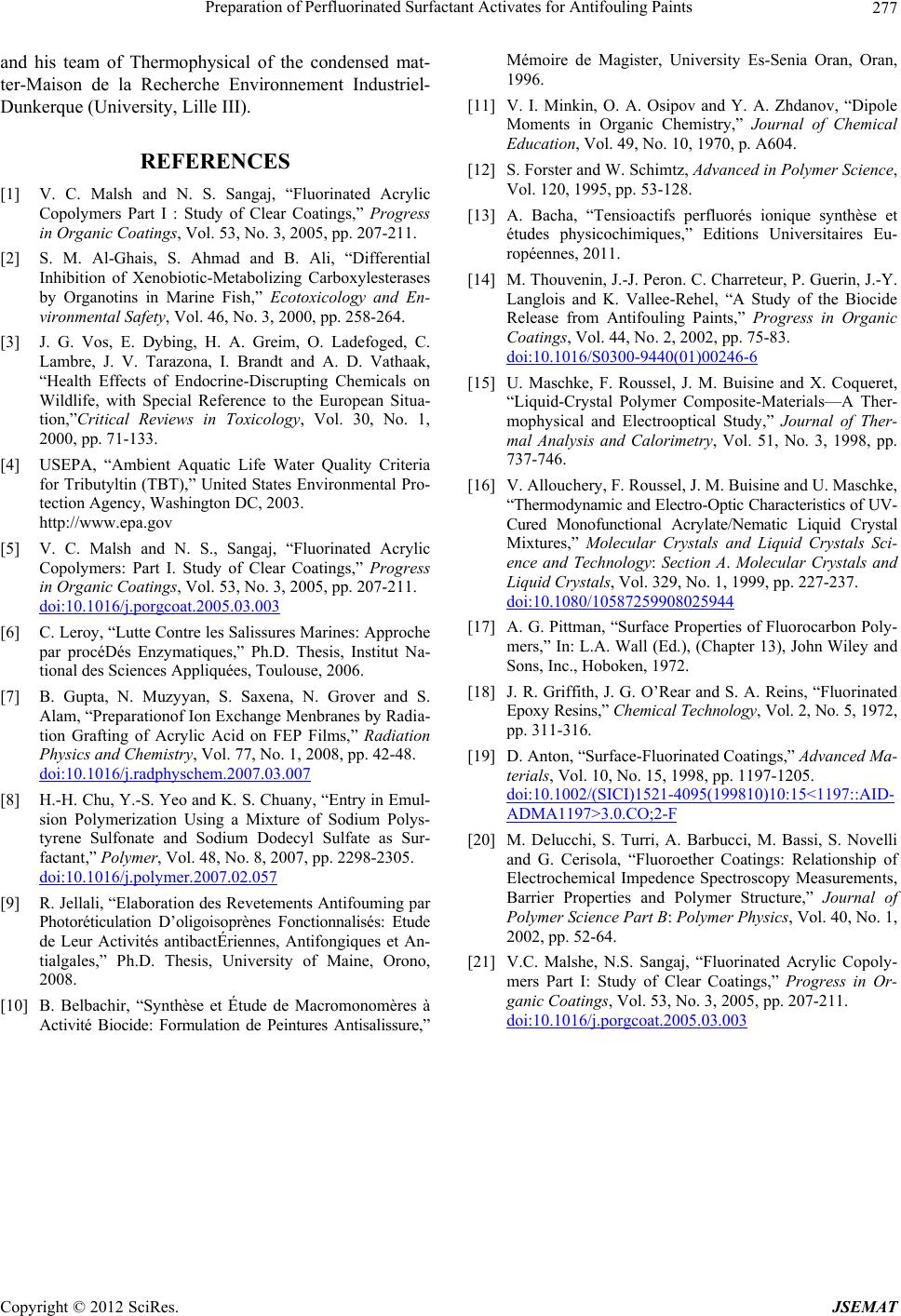
Preparation of Perfluorinated Surfactant Activates for Antifouling Paints
Copyright © 2012 SciRes. JSEMAT
277
and his team of Thermophysical of the condensed mat-
ter-Maison de la Recherche Environnement Industriel-
Dunkerque (University, Lille III).
REFERENCES
[1] V. C. Malsh and N. S. Sangaj, “Fluorinated Acrylic
Copolymers Part I : Study of Clear Coatings,” Progress
in Organic Coatings, Vol. 53, No. 3, 2005, pp. 207-211.
[2] S. M. Al-Ghais, S. Ahmad and B. Ali, “Differential
Inhibition of Xenobiotic-Metabolizing Carboxylesterases
by Organotins in Marine Fish,” Ecotoxicology and En-
vironmental Safety, Vol. 46, No. 3, 2000, pp. 258-264.
[3] J. G. Vos, E. Dybing, H. A. Greim, O. Ladefoged, C.
Lambre, J. V. Tarazona, I. Brandt and A. D. Vathaak,
“Health Effects of Endocrine-Discrupting Chemicals on
Wildlife, with Special Reference to the European Situa-
tion,”Critical Reviews in Toxicology, Vol. 30, No. 1,
2000, pp. 71-133.
[4] USEPA, “Ambient Aquatic Life Water Quality Criteria
for Tributyltin (TBT),” United States Environmental Pro-
tection Agency, Washington DC, 2003.
http://www.epa.gov
[5] V. C. Malsh and N. S., Sangaj, “Fluorinated Acrylic
Copolymers: Part I. Study of Clear Coatings,” Progress
in Organic Coatings, Vol. 53, No. 3, 2005, pp. 207-211.
doi:10.1016/j.porgcoat.2005.03.003
[6] C. Leroy, “Lutte Contre les Salissures Marines: Approche
par procéDés Enzymatiques,” Ph.D. Thesis, Institut Na-
tional des Sciences Appliquées, Toulouse, 2006.
[7] B. Gupta, N. Muzyyan, S. Saxena, N. Grover and S.
Alam, “Preparationof Ion Exchange Menbranes by Radia-
tion Grafting of Acrylic Acid on FEP Films,” Radiation
Physics and Chemistry, Vol. 77, No. 1, 2008, pp. 42-48.
doi:10.1016/j.radphyschem.2007.03.007
[8] H.-H. Chu, Y.-S. Yeo and K. S. Chuany, “Entry in Emul-
sion Polymerization Using a Mixture of Sodium Polys-
tyrene Sulfonate and Sodium Dodecyl Sulfate as Sur-
factant,” Polymer, Vol. 48, No. 8, 2007, pp. 2298-2305.
doi:10.1016/j.polymer.2007.02.057
[9] R. Jellali, “Elaboration des Revetements Antifouming par
Photoréticulation D’oligoisoprènes Fonctionnalisés: Etude
de Leur Activités antibactÉriennes, Antifongiques et An-
tialgales,” Ph.D. Thesis, University of Maine, Orono,
2008.
[10] B. Belbachir, “Synthèse et Étude de Macromonomères à
Activité Biocide: Formulation de Peintures Antisalissure,”
Mémoire de Magister, University Es-Senia Oran, Oran,
1996.
[11] V. I. Minkin, O. A. Osipov and Y. A. Zhdanov, “Dipole
Moments in Organic Chemistry,” Journal of Chemical
Education, Vol. 49, No. 10, 1970, p. A604.
[12] S. Forster and W. Schimtz, Advanced in Polymer Science,
Vol. 120, 1995, pp. 53-128.
[13] A. Bacha, “Tensioactifs perfluorés ionique synthèse et
études physicochimiques,” Editions Universitaires Eu-
ropéennes, 2011.
[14] M. Thouvenin, J.-J. Peron. C. Charreteur, P. Guerin, J.-Y.
Langlois and K. Vallee-Rehel, “A Study of the Biocide
Release from Antifouling Paints,” Progress in Organic
Coatings, Vol. 44, No. 2, 2002, pp. 75-83.
doi:10.1016/S0300-9440(01)00246-6
[15] U. Maschke, F. Roussel, J. M. Buisine and X. Coqueret,
“Liquid-Crystal Polymer Composite-Materials—A Ther-
mophysical and Electrooptical Study,” Journal of Ther-
mal Analysis and Calorimetry, Vol. 51, No. 3, 1998, pp.
737-746.
[16] V. Allouchery, F. Roussel, J. M. Buisine and U. Maschke,
“Thermodynamic and Electro-Optic Characteristics of UV-
Cured Monofunctional Acrylate/Nematic Liquid Crystal
Mixtures,” Molecular Crystals and Liquid Crystals Sci-
ence and Technology: Section A. Molecular Crystals and
Liquid Crystals, Vol. 329, No. 1, 1999, pp. 227-237.
doi:10.1080/10587259908025944
[17] A. G. Pittman, “Surface Properties of Fluorocarbon Poly-
mers,” In: L.A. Wall (Ed.), (Chapter 13), John Wiley and
Sons, Inc., Hoboken, 1972.
[18] J. R. Griffith, J. G. O’Rear and S. A. Reins, “Fluorinated
Epoxy Resins,” Chemical Technology, Vol. 2, No. 5, 1972,
pp. 311-316.
[19] D. Anton, “Surface-Fluorinated Coatings,” Advanced Ma-
terials, Vol. 10, No. 15, 1998, pp. 1197-1205.
doi:10.1002/(SICI)1521-4095(199810)10:15<1197::AID-
ADMA1197>3.0.CO;2-F
[20] M. Delucchi, S. Turri, A. Barbucci, M. Bassi, S. Novelli
and G. Cerisola, “Fluoroether Coatings: Relationship of
Electrochemical Impedence Spectroscopy Measurements,
Barrier Properties and Polymer Structure,” Journal of
Polymer Science Part B: Polymer Physics, Vol. 40, No. 1,
2002, pp. 52-64.
[21] V.C. Malshe, N.S. Sangaj, “Fluorinated Acrylic Copoly-
mers Part I: Study of Clear Coatings,” Progress in Or-
ganic Coatings, Vol. 53, No. 3, 2005, pp. 207-211.
doi:10.1016/j.porgcoat.2005.03.003